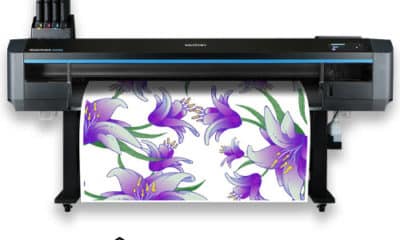Metal Fabrication
A Look at Laminates
How to determine what topcoat to use
Published
17 years agoon

So, 2007 is upon us. I'd like to wish you a very happy and prosperous New Year! To increase your luck and billfold, I hope you've followed New Year's tradition and stuffed yourself with plenty of hoppin' john and collard greens. If you need an explanation, please contact me, and I'll give you a quick education in Southernese.
If you've only recently entered the digital-printing realm, this month's article should add some real "green" to your business. I'll discuss pressure-sensitive adhesive (PSA) laminates, their benefits, application tips and how they add value to your digital prints. So, grab a plate of leftovers and let's talk turkey.
To laminate or not to laminate
Lamination is a conflicting issue in our industry. Protecting prints with a PSA laminate requires investing in a laminator and committing extra space for the machine and its consumables. Alternatively, sending out unprotected prints incurs the risk of customers bringing them back after they've mistakenly cleaned them with an industrial-strength degreaser.
Before we delve too far, let me emphasize that, for the highest protection level, there's no substitute for a PSA laminate over a digital print. So, if you operate a digital printer (in our market, this primarily refers to solvent, eco-solvent and UV-cure printers) in your shop, or plan to invest in one this year, I suggest your next investment be a laminator. Let's look at the benefits this extra layer of protection offers your digital prints.
AdvertisementUV protection. Most laminates in today's market add some type of added protection against the sun's harmful UV rays, which can rapidly fade reds, yellows and other bright colors. Some laminates extend an ink's lifespan, which increases the graphic's durability.
Mechanical protection. Today's digitally printed graphics are subjected to every type of mechanical damage possible. From car washes to curious fingers and everything in between, the graphics must withstand a heavy beating. A PSA laminate will add another layer between an out-of-control grocery cart and your beautiful print.
Production efficiency. As much as digital technology has progressed, your digital printer still isn't a complete, plug-and-play solution. You'll spend time calibrating, changing settings, trying different profiles, etc., until you achieve the desired result. Also, as I'm sure you're aware (or soon will be), every time you load a different media, you'll have to change profiles, adjust settings and re-calibrate once more.
Thus, you'll likely print 80% of your jobs on one particular media to avoid the headache. Well, what happens if your glossy media of choice doesn't match your customer's need for a matte print? No problem; just add a matte-finish laminate to your glossy print, and voil‡! This allows more efficient printing because you won't sustain down time re-loading media and adjusting printer settings.
Warranty. Expect your client to force your hand. If the graphic is short-term, and mechanical damage is unlikely, your customer may not want to spring for the extra cost. However, what happens when the job needs to last three to five years, and your customer wants some type of guarantee? Lamination is a necessity. Fortunately, media manufacturers have developed component-system warranties that protect your graphics, provided you use their matching media and laminates. Read all warranty statements thoroughly; manufacturer policies vary.
When to use what
AdvertisementLet's examine factors that will help you successfully laminate your products. PSA laminates are constructed similarly to the media on which theyÕre printed. Make sure you match your print media to the correct laminate. As a general rule, I strongly suggest using calendered and cast media with their counterpart laminates.
There are, however, exceptions. For instance, premium calendered media can be used with cast laminates. Read the manufacturer's suggestions on matching media with laminates because the laminate may change with each application. Although you may use a cast laminate on an ultra-calendered media for a box truck, it might be overkill to use the same laminate on a 4 x 8-ft., construction sign.
Regardless of which media and laminate manufacturer you use, keep them together. As I noted earlier, most manufacturers offer a component-system warranty.
However, that warranty is voided if you use one manufacturer's media and another's laminate for your prints. Trust me, they know the difference. Also, record your print media and laminate lot numbers on each print job — this will be critical if you ever need to submit a warranty claim.
Details, details
Remember several points to ensure successful lamination and prevent problems before they start. The same solvents that create vivid color can also cause lamination nightmares if you don't follow proper procedures. Your printer can print on uncoated media because a solvent carrier delivers the ink pigment. This solvent carrier penetrates the media surface and finishes the job by implanting the pigment.
AdvertisementHowever, the job isn't completely done, because the solvent must evaporate to allow the media to "close" and cure the inks. Evaporation, or "outgassing," can require 24 hours — just because they feel dry to the touch doesn't mean the inks have fully cured. So, if you pull your new print off the printer and let it sit on a table for only a few hours before lamination, congratulations — you've just sealed the out-gassing solvents into your print.
Residual solvents can lead to one of two bad things. First, they cause tiny bubbles that completely cover the image. In case you were wondering, you can't increase the pressure on your laminator and run the print back through in an effort to squeeze the bubbles out — throw the print in the trash. Also, the solvents are forced back through the media and into the adhesive, which makes the adhesive too aggressive and may trigger graphic failure. Clearly, you donÕt want to experience either gaffe — wait at least 12 to 24 hours before applying your PSA laminate.
Equipment check
We've learned a bit about what to do and not do. Now, let's look at several equipment factors that allow you to print successfully.
Many fantastic laminators are on the market today. ST publishes a comprehensive Buyers' Guide issue every year, and I highly recommend that you peruse it or the online version to see which companies produce laminators that suit your needs.
However, you can have the best laminator in the world, but neglecting a few fundamentals could set you up for failure. First, ensure your laminator remains free of dust or debris. Nothing is more aggravating than printing a spectacular piece, and then trapping little pieces of lint or trash under the laminate.
Also, always ensure that roll tension and tracking run smoothly on your machine. Never set the take-up reel to move faster or slower than the print being laminated. This can place undue stress on the print and lead to failure. If the print doesnÕt track properly with the laminate, you'll probably find creases in your print.
Whether the laminator uses pneumatic or manual pressure, verify that the laminate applies properly to the print. The final product should be transparent, with no trapped air between the print and laminate.
Laying it down
I'm not a laminator expert, but I know lamination is an art unto itself. To perfect this art, I strongly recommend taking any training the manufacturer offers or suggests. The best print will be completely ruined by a bad lamination job.
Conversely, when done properly, lamination gives prints that extra "wow factor" that keeps clients coming back for more. To sell lamination to customers, refer to it as an insurance policy for their graphics. Without it, there's no guarantee.
Craig Campbell is the product-application manager for Oracal USA (Jacksonville, FL).
SPONSORED VIDEO
Introducing the Sign Industry Podcast
The Sign Industry Podcast is a platform for every sign person out there — from the old-timers who bent neon and hand-lettered boats to those venturing into new technologies — we want to get their stories out for everyone to hear. Come join us and listen to stories, learn tricks or techniques, and get insights of what’s to come. We are the world’s second oldest profession. The folks who started the world’s oldest profession needed a sign.
You may like
Advertisement
Subscribe

Magazine
Get the most important news
and business ideas from Signsofthetimes Magazine.
Advertisement
Most Popular
-

 Business Management1 week ago
Business Management1 week agoWhen Should Sign Companies Hire Salespeople or Fire Customers?
-

 Women in Signs1 week ago
Women in Signs1 week ago2024 Women in Signs Award Winners Excel in Diverse Roles
-

 True Tales2 weeks ago
True Tales2 weeks agoSign Company Asked to Train Outside Installers
-

 Editor's Note5 days ago
Editor's Note5 days agoWhy We Still Need the Women in Signs Award
-

 Maggie Harlow2 weeks ago
Maggie Harlow2 weeks agoThe Surprising Value Complaints Bring to Your Sign Company
-

 Line Time1 week ago
Line Time1 week agoOne Less Thing to Do for Sign Customers
-

 Product Buying + Technology7 days ago
Product Buying + Technology7 days agoADA Signs and More Uses for Engraving Machines
-

 News2 weeks ago
News2 weeks agoMUTOH Partners With Wasatch for RIP Software Package











